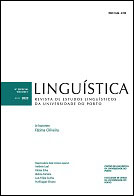Speeches of celebration and enunciative deletion strategies: Use and system
Abstract
The relationship between linguistic system and use is central to the construction of the discourses as communicative practices. This is the theoretical framework from which we propose to analyze how certain grammatical structures are at the service of strategies of enunciative erasure (French effacement énonciatif), as linguistic mechanisms where the voices of discourse are constructed but pretending that they do not exist. It is through the analysis of the structure Há quem X that we intend to show this interrelationship between discourse and system anchored in the concept of dialogism. Our objective is, specifically, to analyze the use of this structure as a discursive strategy of enunciative erasure, in a speech celebrating the Centenary of the Portuguese Republic, held in the Portuguese parliament. It stands out in the analysis that Há quem X is a complex dialogic structure, which serves a strategy of erasing the enunciative voice of the speaker, but also the erasure of other voices, an enunciative process with implications for discourse organization, namely argumentative and illocutionary dimensions, within the ongoing global process of referencing.
References
Authier-Revuz, J. (1982). Hétérogénéité montrée et hétérogénéité énonciative: éléments pour une approche de l’autre dans le discours. DRLAV. Documentation et Recherche en Linguistique Allemande Vincennes,26(1), 91-151.
Bakhtine, M. (1984). Esthétique de la Création Verbale. Gallimard.
Benveniste, E. (1970). L’appareil formel de l’énonciation. Langages, (17), 12-18.
Berrendonner, A. (2010). Autour d’une définition linguistique des notions de voix collective et de on-locuteur. In M. Colas-Blaise, M. Kara, L. Perrin & A. Petitjean (eds), La question polyphonique ou dialogique en sciences du langage (pp. 39-64). Université Paul Verlaine-Metz.
Brès, J. (2001). Analyse du Discours et Dialogisme. Diacrítica, 16, 249-263.
Brès, J. (2009). Dialogisme et temps verbaux de l’indicatif. Langue Française, (3), 21-39.
Brès, J., & Mellet, S. (2009). Une approche dialogique des faits grammaticaux. Langue Française, (3), 3-20.
Charaudeau, P. (1992). Grammaire du sens et de l’expression. Hachette.
Charaudeau, P. (2004). Visadas discursivas, gêneros situacionais e construção textual. In I. L. Machado, & R. Mello (Eds.), Gêneros - reflexões em análise do discurso (pp. 13-41). Núcleo de Análise do Discurso / Faculdade de Letras - Universidade Federal de Minas Gerais.
Charaudeau, P. (2014). Da linguística da língua à linguística do discurso, e retorno. Revista Desenredo,10(2), 227-236. http://seer.upf.br/index.php/rd/article/view/4155
Duarte, I. M. (2018). Marquers présentatifs dans des intéractions informelles en Portugais Européen. Studia Universitatis Babes-Bolyai Philologia, 63(2), 269-284.
Ducrot, O. (1984). Le dire et le dit. Éditions de Minuit.
Fiorin, J. L. (2017). Uma teoria da enunciação: Benveniste e Greimas. Gragoatá, 22(44), 970-985. file:///C:/Users/Utilizador/Downloads/33544-Texto%20do%20Artigo-111795-1-10-20180228.pdf
Fonseca, J. (1992). Linguística e Texto/Discurso - Teoria, Descrição, Aplicação. Instituto de Cultura e Língua Portuguesa.
Kerbrat-Orecchioni, C. (1980). L’énonciation. De la subjectivité dans le langage. Armand Colin.
Kuhn, T. (1983). La structure des revolutions scientifiques. Flammarion.
Lopes, A. C. M. (2009). Justification: a coherence relation. Pragmatics, 19(2), 223-239. http://hdl.handle.net/10316/47870
Marques, M. A. (2000). Funcionamento do Discurso Político Parlamentar – a organização enunciativa no Debate da Interpelação ao Governo. Universidade do Minho. Instituto de Letras e Ciências Humanas (ILCH).
Marques, M. A. (2013). Construir a responsabilidade enunciativa no discurso jornalístico. REDIS: Revista de Estudos do Discurso, 2, 139-165. http://ler.letras.up.pt/uploads/ficheiros/12760.pdf
Marcuschi, L. A. (2008). Produção textual, análise de gêneros e compreensão. Parábola.
Mellet, S. (2009). Dialogisme, parcours et altérité notionnelle : pour une intégration en langue du dialogisme?. Langue française, (3), 157-173.
Philippe, G. (2002). L’appareil formel de l’effacement énonciatif et la pragmatique des textes sans locuteur. In R. Amossy (Ed.), Pragmatique et analyse des textes (pp. 17-34). Presses de l’université de Tel-Aviv.
Rabatel, A. (2001). Valeurs énonciative et représentative des ’présentatifs’ C’EST, IL Y A, VOICI/VOILA: effet point de vue et argumentativité indirecte du récit. Revue de sémantique et pragmatique, (9-10), 43-74.
Rabatel, A. (2003). Le point de vue, entre langue et discours, description et interprétation : état de l’art et perspectives. Cahiers de praxématique, (41), 7–24.
Rabatel, A. (2004). Stratégies d’effacement énonciatif et posture de surénonciation dans le Dictionnaire philosophique de Comte-Sponville. Langages, (4), 18-33.
Rabatel, A. (2005). La part de l’énonciateur dans la construction interactionnelle des points de vue. Marges Linguistiques, (9), 115-136.
Rabatel, A. (2009). A brief introduction to an enunciative approach to point of view. In P. Hühn, W. Schmid, & J. Schönert (Eds.), Point of view, perspective and focalization (pp. 79-98). De Gruyter.
Rabatel, A. (2017). Pour une lecture linguistique et critique des médias. Empathie, éthique, point(s) de vue. Lambert-Lucas.
Rabatel, A. (2019). Énonciateurs Premiers, Seconds, Points de Vue, Modalité et Intentionnalité aux Défis de l’Interprétation. Recherches en Langue et Littérature Françaises, 13(23), 165-188. http://france.tabrizu.ac.ir/
Vion, R. (2001). Effacement énonciatif et stratégies discursives. In A. Joly, & M. de Mattia (Eds.), De la syntaxe à la narratologie énonciative. Textes recueillis en hommage à René Rivara (pp. 331-354). Ophrys.
Wittgenstein, L. (2000). Investigações filosóficas (J. C. Bruni, Trad.). Ed. Nova Cultural (Original publicado em 1953).
Downloads
Published
Issue
Section
License
Copyright (c) 2022 Linguística: Revista de Estudos Linguísticos da Universidade do Porto

This work is licensed under a Creative Commons Attribution-NonCommercial 4.0 International License.



